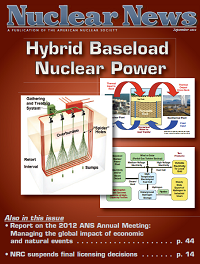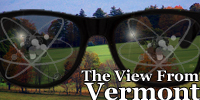122nd Carnival of Nuclear Energy Bloggers
 The weekly Carnival is the collective voice of blogs by many of the Internet's foremost nuclear experts and advocates, who continue each week to tell the story of nuclear energy around the World Wide Web.
The weekly Carnival is the collective voice of blogs by many of the Internet's foremost nuclear experts and advocates, who continue each week to tell the story of nuclear energy around the World Wide Web.
The ANS Nuclear Cafe is a blog owned and edited by the American Nuclear Society. Information contained on the ANS Nuclear Cafe has been provided by numerous sources. Therefore, the American Nuclear Society assumes no responsibility or liability for the accuracy of information contained herein. DISCLAIMER: The views expressed in posted articles do not necessarily reflect the views of the American Nuclear Society. The views expressed here are those of the individual authors. ANS takes no ownership of their views. The American Nuclear Society assumes no responsibility or liability for any use or operation of any methods, products, instructions, or ideas contained on this site.

A message from Goodway Technologies
Optimizing Maintenance Strategies in Power Generation: Embracing Predictive and Preventive Approaches
 The weekly Carnival is the collective voice of blogs by many of the Internet's foremost nuclear experts and advocates, who continue each week to tell the story of nuclear energy around the World Wide Web.
The weekly Carnival is the collective voice of blogs by many of the Internet's foremost nuclear experts and advocates, who continue each week to tell the story of nuclear energy around the World Wide Web.
At the ANS 2012 Annual Meeting, ANS Public Information Committee's Dan Yurman caught up with Dr. Wade Allison, of Oxford University, UK. They discussed radiation, health effects, Fukushima, Dr. Allison's recent book Radiation and Reason, and Dr. Allison's recent trip to Japan in this video interview.
 The September issue of Nuclear News magazine is available in hard copy and electronically for American Nuclear Society members (click 'ANS Members' in left column).
The September issue of Nuclear News magazine is available in hard copy and electronically for American Nuclear Society members (click 'ANS Members' in left column).
 A few months ago, I wrote about the need to have an active dialogue between the nuclear community and the climate change community. Since then, the severity of the drought in the Midwest has continued to worsen and push up food prices, the Mississippi River has been intermittently closed due to low water levels, some private wells are running dry, and the arctic sea ice just hit a new record low.
A few months ago, I wrote about the need to have an active dialogue between the nuclear community and the climate change community. Since then, the severity of the drought in the Midwest has continued to worsen and push up food prices, the Mississippi River has been intermittently closed due to low water levels, some private wells are running dry, and the arctic sea ice just hit a new record low.
The draft SEIS meeting for disposition of surplus weapons plutonium in MOX fuel started out relatively smoothly-lots (and I mean lots) of pro-nuclear folks in the room; my initial estimates would put the pro-nuclear folks from the University of Tennessee and Chattannooga State University at over half the crowd present. No zombie sightings as of yet.
A quick shot of the ANS member room before the open house kicked off - students in the royal blue t-shirts are with the Chattanooga State ANS Student Section.
Hi folks, Steve Skutnik here-you may know me from The Neutron Economy blog. I'm also currently an assistant professor of nuclear engineering at the University of Tennessee. I'll be here with Suzy Hobbs-Baker (of PopAtomic Studios) and Laura Scheele live-blogging the public hearing on the use of surplus weapons plutonium in MOX fuel. I've also got a healthy contingent of eager students from the University of Tennessee here as well, eager to speak up for the nonproliferation benefits of disposing of surplus plutonium in MOX fuel.
WHO:
On August 16, G. Ivan Maldonado, PhD, Associate Professor of Nuclear Engineering with the University of Tennessee-Knoxville, attended a Tennessee Valley Authority (TVA) Board Meeting on behalf of the American Nuclear Society to present comments on the use the of mixed uranium-plutonium oxide (MOX) fuel technology to accomplish the timely disposition of surplus weapons-grade plutonium.
 When the heat released by nuclear fission is used in a steam plant to produce mechanical power, the second law of thermodynamics dictates that a large part of the heat must be rejected to the environment. Most land-based nuclear plants reject heat by using cooling water from a river or ocean.
When the heat released by nuclear fission is used in a steam plant to produce mechanical power, the second law of thermodynamics dictates that a large part of the heat must be rejected to the environment. Most land-based nuclear plants reject heat by using cooling water from a river or ocean.
The 121st weekly Carnival of Nuclear Energy Bloggers is up at Next Big Future.
Running a nuclear reactor is so easy that undergraduates can do it. And they do, at the research reactor at Reed College in Portland, Oregon (by the way, that's where Steve Jobs went to school).
Government auditor cites lack of regulatory independence and says overall effectiveness is weak
Labor Day is the traditional marking point for the end of summer-and time for back-to-school activities for K-12 students. Back to School season also provides an opportunity to help students understand the kind of work that nuclear engineers and scientists do. Your participation can interest a young person in pursuing an engineering career!
The 120th weekly Carnival of Nuclear Energy Bloggers is up at The Hiroshima Syndrome.
On Friday, August 31, Yes Vermont Yankee passed a milestone of 200,000 page views. Yes Vermont Yankee covers Vermont energy issues and favors the relicensing of the Vermont Yankee Nuclear Power Plant.
America's first new nuclear energy reactors in 30 years are currently under construction at the Alvin W. Vogtle Electric Generating Plant in Burke County, Georgia. The ANS Nuclear Matinee takes viewers behind the scenes of this amazing project (courtesy of Southern Nuclear Company who produced the excellent video updates).
The September 2012 edition of the technical journal Nuclear Technology is available electronically and in hard copy for American Nuclear Society member subscribers and others.
When I was registering for the various events scheduled to take place during the ANS Annual Meeting this past June, I was quite excited to see that one of the three technical tours would be at Exelon's Dresden Nuclear Station, not too far from downtown Chicago where the meeting was taking place. Luckily, I made the cut for attendance and was issued a ticket for the tour when I checked in at the meeting desk.